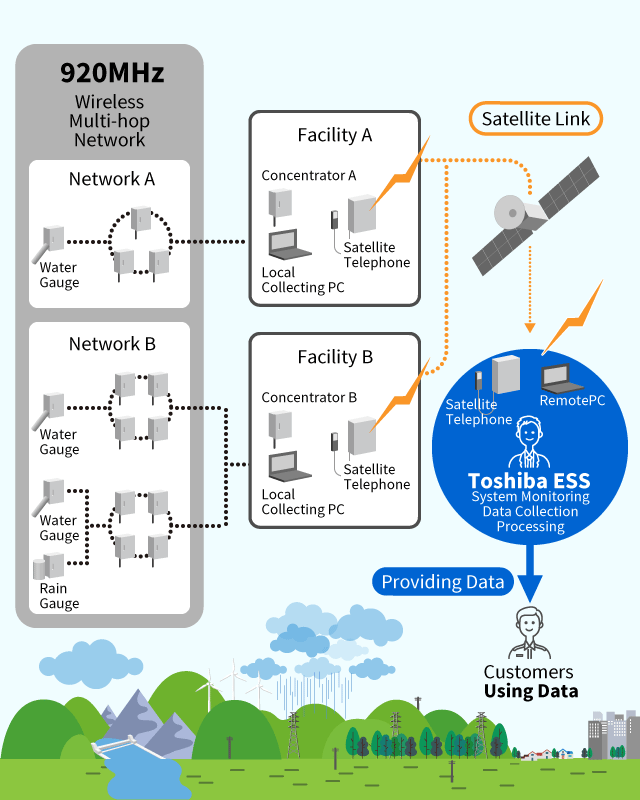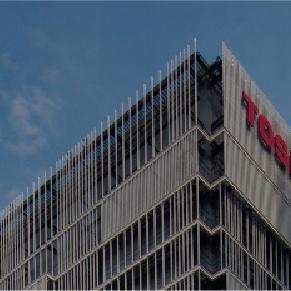Toshiba Starts the first Data Collection Service using LPISTM
Reliable Data Collection of Rainfall and Water Levels from Mountainous RegionsNEWS RELEASE
Digital Transformation
New products / services
Toshiba Energy Systems & Solutions Corporation
KAWASAKI, JAPAN―Toshiba Energy Systems & Solutions Corporation (hereinafter “Toshiba ESS”) announced today that it has started a data collection service by using its “Low Power IoT Solution”, LPIS™. This service is a relay system from four water-level and rainfall observation stations at Chubusangaku National Park in Omachi City, Nagano Prefecture, under contract of TEPCO Renewable Power. It is the first commercial subscription-based data collection service using Toshiba ESS’s LPIS™.
The majority of the water-level and rainfall observation stations in this project are located deep in the mountains, which makes it difficult to collect rainfall data by road vehicles because it takes five to six hours for workers to reach the area. Data collection is an important task, especially during the rainy season or winters with heavy snowfall. To make this task easier, Toshiba ESS has set up approximately 20 relay devices, creating a 4-km-long wireless network, and by using a satellite telephone network, the company is able to collect data from the head office.
The relay equipment is set up in the park with portable self-standing poles so as not to disturb the environment. Under adverse conditions, such as landslides, floods, or avalanches, relay devices rendered inoperable can be reinforced by the surrounding equipment, ensuring reliable data collection service. Furthermore, the operation of each relay is monitored remotely from the head office. By providing reliable services to our customers, the data can be used to make power generation analysis more efficient.
Toshiba ESS was able to obtain useful data from field validation experiments using LPWA*1 to monitor the water levels of rivers and streams in Hokkaido from 2018 to 2019. The company is using this data toward the commercialization of the technology; the first solution, using LPIS™, was supplied this past February. The company evaluated these initiatives, and by using the characteristics of a one-stop service, which can collect data for operation and maintenance, Toshiba ESS launched the service commercially.
There are more than 1,500 hydropower stations in Japan, highlighting the high demands of data collection from within mountainous ranges. From the perspective of improving equipment availability and fault prediction, it is expected that LPIS™ can be used to fulfill the needs of data collection in industrial application.
Yasutaka Arai, Project Manager of the Toshiba ESS DX Business Design Project Team, said, “It is our great honor to launch the first data collection service using LPIS™.
We will increase the availability of LPIS™ by offering subscriptions or solution-based services in response to market needs.”
Toshiba ESS will continue to provide IoT solutions, beginning with LPIS™, to the market as a global leader in CPS*2 technology.
Overview and System Configuration of LPIS™
LPIS™ is a subscription-based service using LPWA, low-power wireless multi-hopping technology*3 to achieve reliable data transmission, even within mountainous ranges that are outside the reach of telecommunication towers. Data transmitted by wireless equipment, called sensor nodes, in 920-MHz band radio waves is forwarded through relays in the form of bucket relays to a concentrator, which then transmits the pooled data through a WAN*4 network. The sensor nodes and relays use a proprietary low energy design to ensure long operation using dry cell batteries; a wireless network can be configured easily by setting up the relays.

*1 LPWA (Low Power Wide Area): A general term for a wireless technology that covers a wide area with low-power consumption.
*2 CPS (Cyber Physical System): The mechanism of creating added value by collecting data in the real world and analyzing it in the cyber world using digital technology, considering it as information and knowledge that is easy to utilize, and feeding it back to a physical system.
*3 A communication method which can cover a wide communication range by relaying data using a relay system.
*4 WAN (Wide Area Network): A transmission circuit network that a communication enterprise installs and employs by the communication network which connects between geographically distant points.
Information in the news release, including product prices and specifications, content of services and contact information, is current on the date of the news release , but is subject to change without prior notice.




